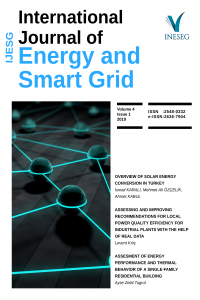THE DESIGN OF A SMART ENERGY MANAGEMENT SYSTEM FOR MICROGRIDS
THE DESIGN OF A SMART ENERGY MANAGEMENT SYSTEM FOR MICROGRIDS
Microgrids, smartgrids, energy management system,
___
- Rathnayaka A, Potdar V, Dillon T, Hussain O, Kuruppu S., Goal-oriented prosumer community groups for the smart grid, IEEE Technol. Soc. Mag., 33 (2014), 41–8.
- Woldeyohannes A.D., Woldemichael D. E., Sustainable renewable energy resources utilization in rural areas, Renewable and Sustainable Energy Reviews, 66 (2016)1–9.
- Bird L., Lew D., Milligian M., Carlini E.M., et all., Wind and solar energy curtailment: A review of international experience, Renewable and Sustainable Energy Reviews, 65(2016), pp.577–586.
- Khare V., Nema S., Baredar P., Solar–wind hybrid renewable energy system:A review, Renewable and Sustainable Energy Reviews, 58(2016), 23–33.
- Al-falahi M.D.A., Jayasinghe S.D.G., Enshaei H., A review on recent size optimization methodologies for standalone solar and wind hybrid renewable energy system, Energy Conversion and Management, 143 (2017), pp. 252–274.
- Özçelik M.A., The Design and Implementation of PV -Based Intelligent Distributed Sensor LED Lighting in Daylight Exposed Room Environment, Sustainable Computing: Informatics and Systems, 13(2017), pp. 61-69.
- Liu G., Starke M., Xiao B., Tomsovic K., Robust optimisation-based microgrid scheduling with islanding constraints, IET Generation, Transmission & Distribution, 11(2017), 7, pp.1820-1828.
- The CERTS Microgrid Concept, https://certs.lbl.gov/sites/all/files/lbnl-50829.pdf, accessed September 2017.
- ISSN: 2548-0332
- Başlangıç: 2016
- Yayıncı: Zülküf GÜLSÜN
THE DESIGN OF A SMART ENERGY MANAGEMENT SYSTEM FOR MICROGRIDS
Ali Utma, Mehmet Ali Özçelik, Ahmet Serdar Yılmaz
A MODEL APPLICATION OF MICRO GRID: BATMAN UNIVERSITY MICRO GRID
Mehmet Eşref DEMİR, Musa YILMAZ, Ahmet GÜNDOĞDU
SOLAR DEVELOPMENT IN UZBEKISTAN. STEP 1: SOLAR DATA COMPILATION
Nilufar Avezova, Shirin Sadullaeva, Ergashali Rakhimov, Nizomjon Usmonov
UZBEKISTAN RENEWABLE ENERGY SHORT OVERVIEW: PROGRAMS AND PROSPECTS
Nilufar AVEZOVA, Azizboy KHAITMUKHAMEDOV, Akmal VOKHIDOV
COST ANALYSIS OF MINI HYDRO POWER PLANT USING BACTERIAL SWARM OPTIMIZATION
